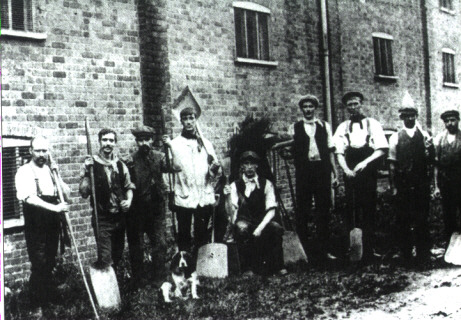Hertford’s wealth was founded on the brewing industry. The main crop was barley which thrived in the light well drained soil that surrounded Hertford. It produced the short, plump, thin-skinned variety that every maltster desired.
Hertford’s pre-eminence was born out of a simple geographic alliance.
Barley is brought in from the fields to the maltings where it is soaked in water to convert the starch into sugar and then heated to arrest germination before the addition of yeast to produce alcohol. The temperature is controlled to give either a pale malt or roasted to produce the dark malts for stout and porter – particular favourites of Londoners.
Londoner’s had always drunk beer; it was healthier than untreated water from the Thames. This demand was met by the brewers who had traditionally sourced malt, the raw material for beer, from three main areas; Surrey, Bedfordshire and Hertfordshire.
The second natural advantage of Hertford’s ascendancy was the river Lea. It flows straight from the centre of the town until running in to the Thames directly into the heart of London. Here the great brewing names such as Whitbread, Perkins and Coombe built riverside warehouses to accept the continuous barges of malt.
Almost as soon as the Navigation Acts were passed in the middle of the eighteenth century allowing for the improvement of barge transport into Hertford (see my page on Folly Island), events were occurring elsewhere that were to threaten Hertford’s pre-eminence as a malting and brewing centre.
Hertford’s decline
East Anglia was establishing itself as a major source of barley and barges using the sea route from Norfolk to London’s Bear Quay were accounting for a higher proportion of London’s malt imports. The big brewers were establishing their own maltings and factoring houses and their dependence on local supplies such as from Hertford was diminishing.
Local malting was dealt a mortal blow by the new industrial age – and in particular, the coming of the railways. See my page on George Bradshaw, author of the eponymous railway guides and timetables. The railway opened up the Midlands and its fields of barley.
Burton soon became the new centre of the malting industry and as overseas exploration cast light on dark corners of the globe, it was Burton ales such as the eponymous IPA (India Pale Ale) that was shipped to the colonies.
Ironically beer in bottles such as IPA lasted the journey better; a discovery said to have been made in Hertfordshire by a parson from Much Hadham, Alexander Nowell. On one of his frequent fishing days he accidentally left a bottle of home brewed beer on the riverbank.
It was his custom to put a stopper in the bottle to prevent the contents being spilled and on his return a few days later he found that the beer in the stoppered bottle had improved greatly – and thereby, so tradition has it, invented bottled beer.
The Quaker Henry Stout and malting
The dark brown beer called porter was said to have been invented by a Londoner. If this is so then it is safe to assume that the malt used to produce porter was developed in Hertfordshire, for this area was famous for its brown malts.
The invention of stout was first mentioned in 1677 and accredited to Henry Stout. This is now doubted as Henry Stout was actually a maltster and stout is a reference to any dark, strong ale. He owned property in and around Hertford and also ran the White Lion in Fore Street.
Quakers of which Henry Stout was one, became involved in the brewing industry as this was one of the few professions that were still open to them following the restoration of Charles II.
Quakers were penalised for not taking oaths in courts of law or standing for political positions. Henry Stout was penalised in 1662 and 1664 for non-attendance at church.
William Fairman was sentenced in 1677 to be deported to Barbados. It is thought that he served his sentence in this country as in 1687 he provided liquor to the Assizes to accompany the judge’s meal of ‘boyle beef, porch, rost beef and cheese’.
The Mysterious Death of Sarah Stout – Sarah, daughter of Henry, was found in the River Lea in March, 1699. William Cowper, son of the local MP stood trial for her murder. The backgrounds of all involved, the trial and a new solution can be found in this book.
Modern day Hertford
Henry Stout’s White Lion has disappeared but Fore Street was a popular venue for anyone with a thirst. Numbers 41 – 49 now all retail units, was a brewery and number 42, the Turk’s Head Coffee House had a brewery in the yard and was situated in what is now known as Brewhouse Lane; numbers 72 – 74 was known as the Falcon between 1727 and 1731 and now houses a firm of solicitors. The Red Lion had a brewery behind the bar as long ago as 1621. In 1731 it was called the Half Moon and early in the 1800’s became the Dimsdale Arms. It is now the Pizza Express.
Many of Hertford’s pubs are listed in the latest edition of the Good Beer Guide and all are worth a visit.
Modern street names such as Barley Croft, Brewhouse Lane and The Maltings remain as a reminder of Hertford’s strong association with brewing.
All evidence of a once thriving industry has all but vanished but on days when the wind is in the right direction the smell of hops still drifts over Hertford from McMullens brewery, the last remaining independent brewer in the town.
Many of Hertford’s pubs are mentioned in the Good Beer Guide by CAMRA from Amazon.
More articles on Hertford:
Hertford the county town, Folly Island, Hidden Hertford, Old Barge Pub, Brewing in Hertford, Easter, Fore Street, Eccentric Clergy, Hertford Library, Hertford 1861, Tunnels of Hertford, Sarah Stout, Closed pubs
© John Barber. First published Hertfordshire Countryside, April 2001
